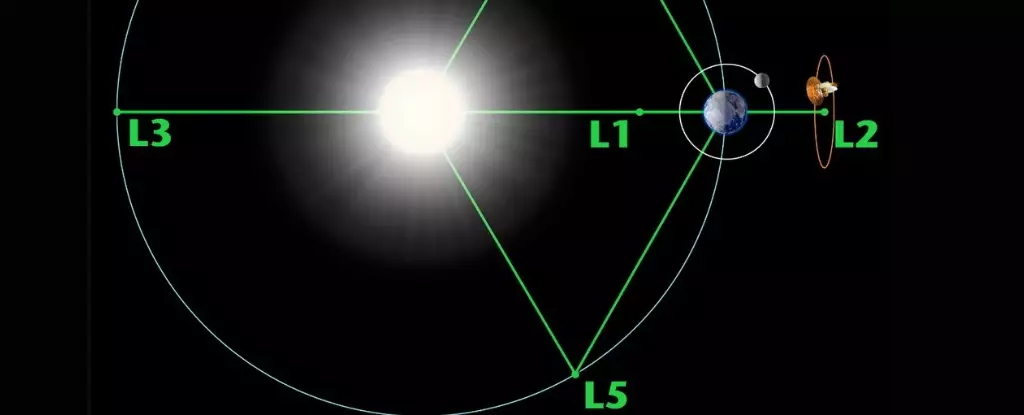The exploration of space has ignited a new “space race” between the United States and China, with Lagrange points emerging as a critical battleground. Named after the renowned astronomer Joseph-Louis Lagrange, these points in interplanetary space represent locations where the gravitational pull of two celestial bodies achieves equilibrium with the centripetal force required for a smaller object to orbit between them. In the Sun and Earth-Moon system, there are five distinct Lagrange points: L1 to L5. These points of gravitational interaction offer stability, making them ideal for satellites and telescopes. Additionally, Lagrange points provide an unobstructed view of deep space, making them valuable for scientific discoveries and observations.
L4 and L5 are two of the most prominent Lagrange points, positioned 60 degrees ahead and behind Earth as it orbits the Sun. These locations offer remarkable stability, requiring minimal fuel adjustments to maintain position. Satellites and telescopes stationed at L4 and L5 can provide a continuous view of Earth, its natural satellite, and facilitate the observation of weather patterns. Moreover, the absence of atmospheric interference and the proximity of L1 and L2 to the Moon make these points attractive for scientific research and communications. Undoubtedly, the control over these Lagrange points grants a significant advantage in terms of space exploration, communications, and surveillance.
L2, located approximately 1.5 million kilometers (932,000 miles) “behind” Earth from the Sun’s perspective, orbits the Sun at the same speed as Earth but at roughly four times the distance from Earth to the Moon. From Earth’s vantage point, L2 lies behind the Moon, offering an unobstructed view of deep space. This strategic position makes L2 an ideal location for sensitive telescopes like the James Webb Space Telescope (JWST). China recognized the significance of L2 and has already dispatched the Queqiao relay satellite to establish communication for their Chang’e 4 lunar probe, the first spacecraft to land on the far side of the Moon. Meanwhile, the United States has its sights set on L2 in the Earth-Moon system for future missions, such as the Gateway lunar outpost planned for the late 2020s. As space systems engineer Laura Duffy highlighted, increased visibility into the far side of the Moon affords invaluable opportunities for scientific exploration.
The fierce competition between the United States and China in space exploration reflects broader economic and technological rivalries. A recent report by a bipartisan committee in the House of Representatives emphasizes the importance of NASA and Department of Defense funding to maintain dominance in space governance, counteract the Chinese Communist Party’s (CCP) influence, and promote scientific discovery and American innovation. The report includes numerous policy recommendations to “fundamentally reset” the relationship with China, with one suggestion standing out: the United States should become the first country to permanently station assets at all Lagrange points. This sentiment underscores the recognition of the strategic value of Lagrange points in maintaining supremacy in space exploration.
China has made significant strides in its space program in recent years, showcasing remarkable progress. Missions like the Chang’e 5 lunar sample return and the upcoming Chang’e 6 mission to the Moon’s south pole highlight their ambitious goals. On top of that, China has successfully launched its space station, Tiangong. Their ultimate objective is to send taikonauts (Chinese astronauts) to the Moon, solidifying their position as a leading space-faring nation. Acknowledging China’s rapid advancements, the bipartisan committee report emphasizes the CCP’s understanding of the significance of space-based operations.
While the competition between the United States and China in space exploration is intense, there is also notable collaboration among multiple countries. The International Space Station exemplifies this cooperative effort, advancing our understanding of the Universe through joint missions. Furthermore, Lagrange points have captured the attention of the international community, with organizations like the European Space Agency developing their own missions to these strategic locations. The focus on Lagrange points in the new space race highlights the global interest in pushing the boundaries of space exploration and expanding our knowledge of the cosmos.
The battle for Lagrange points represents a new era in space exploration, accentuating the rivalry between the United States and China. These points offer stability, proximity to the Moon, and unobstructed views of both Earth and deep space, making them strategic assets for scientific research and communication. The competition for dominance in space governance and technological advancements is evident in the race to control Lagrange points. While this rivalry is concerning, it also drives progress and innovation. As countries strive to unlock the mysteries of space, the use and exploration of Lagrange points continue to shape the future of space exploration.


Leave a Reply